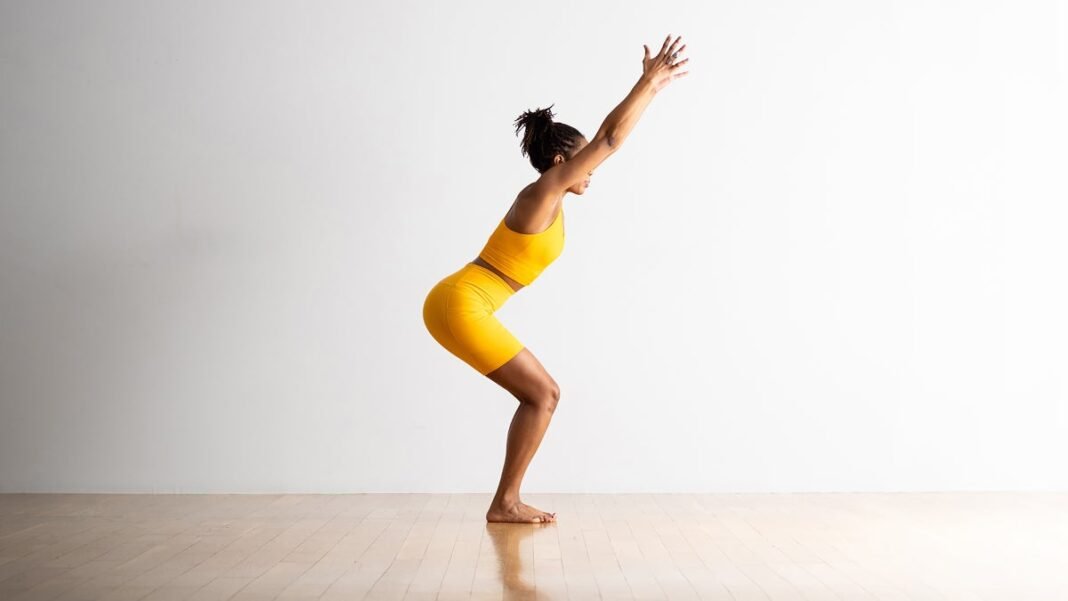“], “filter”: { “nextExceptions”: “img, blockquote, div”, “nextContainsExceptions”: “img, blockquote, a.btn, a.o-button”} }”>
I’ve been accused by students of really liking Utkatasana. I say “accused” because that seems to be the tone people take when they point this fact out. It is with both curiosity and confusion that students say things like, “Wow, you really like Chair Pose.” It’s as if they are subtly questioning how anyone could like such a pose—or perhaps they are not-so-subtly implying that I teach it too frequently.
Utkatasana is a pose that is often either rushed past, as in the flow of Surya Namaskara B (Sun Salutation B), or held for seemingly interminable lengths of time. It is hardly mentioned when the topic of favorite yoga poses come up in conversations with students.
Yet I do love Chair Pose. I love how grounding it is. I love how powerful I feel in it. While we refer to Utkatasana as Chair Pose, the Sanskrit translation of the word “utkata” is actually more along the lines of “fierce, powerful, proud.” Many equate yoga with increased flexibility, but let us remember that asana is actually thought of as a balance between being both supple and strong. Steadiness and ease. Therefore, strength-building is equally as important to our yoga practice as stretching and “spicing” up our squats will not only help our Utkatasana be fiercer and fierier, but the stronger we get in this staple posture, the more ease we will find in other poses, too.
The benefits of Chair Pose
Perhaps the most obvious benefit of the pose is thigh strengthening—both in the quadriceps, one of which flexes the hip and which engage antagonistically to stabilize the body in a bent knee shape, and in the hamstrings, which engage to bend the knee.
But the upper body is also greatly benefited by this pose. In many ways, the fierceness of the pose comes from the ability to stand tall, keeping your spine lengthened and arms reaching, even as gravity and pressures (like tired legs!) are pulling at you to collapse a little. And though it may seem counterintuitive, the stronger your legs, the more space the upper body has to lift and lengthen. So the obvious solution to struggling with Chair Pose is to strengthen your legs.
How to strengthen your Chair Pose
I am a huge believer in cross-training to support our yoga practice. After sustaining multiple injuries over the years due to an aggressive practice and hypermobility, I learned that doing cardio and strength-building are essential to sustaining a safe asana practice. What better leg strengthening workout for Chair than squats? They strengthen our glute and leg muscles. There are innumerable variations, some of which help improve upper body strength and shoulder mobility.
Overall, squats inform their yoga cousin, Utkatasana. By practicing them regularly, those 10-breath holds in vinyasa class will no longer feel like torture. They might even feel more like home.
5 ways to make your Chair Pose even fiercer
1. Wall squat
Why it helps: Many people mistakenly think Chair Pose is all about how low you can go in terms of bending your knees. This often leads to the weight going into the toes and the knees going ahead of the ankles, all of which puts pressure on the front of the knees. In an aligned Chair Pose, your weight actually shifts back, toward your heels. This mild wall squat variation helps you find the action of drawing your shins and hips back, which stabilizes your ankles and protects your knees.
How to: Stand with your back against a wall and bring your hands onto your hips. Step your feet hip-width and walk them forward about 2 feet. Slide your bum down the wall, bending your knees toward 90 degrees. Align your ankle with your knees and your knees with your hips. Once there, hold the pose and without actually moving your feet, pull your heels back toward the wall. Breathe. Your torso is upright against the wall, with your front ribs releasing down and chest lifting. You can keep your hands on your hips or play with reaching the arms up in line with ears. Keep your ribs releasing down. Gaze straight ahead. Breathe for 10 breaths. Place your hands on the wall for balance and straighten the legs to stand back up. Take a brief rest and repeat one more time.
2. Squat with feet apart and a strap around your thighs
Why it helps: The hips are one of the more mobile joints in the body. Chair pose challenges this as it requires a confluence of actions in the hips—the inner thighs rotate in and down, the outer hips adduct, and the hips are flexed. But there is also a slight action of abduction happening in the inner thighs, which helps to keep space in the hip joint. This is challenging to feel when the legs are together or you’re holding Chair interminably. This squat variation helps you find that balance of abduction and adduction, keeping the thighs safely situated in the socket, which in term can allow you to sit lower.
How to: Adjust a strap so it fits snugly around your thighs, just above the knees, when your feet are hip-width apart. As you begin to exhale, sit back into your squat, bending your knees with your bum reaching back. Focus on pressing out into the band, while keeping your knees aligned with your ankles. After your exhale, stand back up, straightening your arms by your sides. Do this 10 times, breathing slowly.
3. Jump squats
Why it helps: So many of the movements we do in yoga are isometric, meaning a muscle is being strengthened without shortening or lengthening it. This is because we hold postures, working against our own body weight and gravity. Chair is like that. Jump squats are the opposite of that. They build what is called “explosiveness,” which is the ability to propel one’s body forward or up in space. In other words, flying. What’s fiercer than that?
How to: Step your feet hip-width apart. Exhale as you bend towards your traditional squat, with your elbows bent by your sides. As you inhale, push off the floor and jump as high as you can, letting your arms swing up in line with your shoulders while keeping your elbows bent. When you land back down, let your arms swing back in line with your waist. Jump slowly to build maximum strength and control. Jump for 10 rounds.
4. New-kid-on-the-block-asana
Why it helps: YogaWorks teacher trainer and self-described “anatomy dork” Jennie Cohen created this spicy squat. As Cohen explains, “In traditional Utkatasana, your quads lengthen across your knees as they contract to control your descent. This variation builds thigh strength with the quads in an elongated position. Since muscles are disadvantaged in very lengthened states, there’s value to training them there, as well as in midrange where they’re most powerful.” Using a block under the heels mitigates ankle flexion, allowing your knees to bend more deeply.
How to: Step onto a low block as if you were putting on a pair of high heels. The block will be underneath your heels and your ball mounds and toes will be on the floor. Inhale and reach your arms overhead in line with your ears or place your hands on your hips if balance is challenging. As you exhale, bend your knees deeply, as if you were going to sit onto the block. Inhale and engage your legs to stand right back up. Exhale, release your arms by your sides. Repeat this for 8 rounds. If the block is too high or unsteady, Cohen recommends using a folded blanket or firmer throw pillow under the heels. You can also roll the front edge of your mat if you don’t have any props.
5. Squat with a block overhead
Why it helps: In traditional yoga postures, we do not use additional weight. Instead, we rely on the resistance of our own body and gravity to build strength. Many yogis fear that lifting weights will lead to bulky muscles, but lifting heavy objects like weights can be one of the best ways to access the smaller stabilizing muscles. This is particularly true of the rotator cuff muscles, which help keep the arm bone safely attached to the shoulder socket. This is essential in weight-bearing poses such as Plank Pose, Adho Mukha Svanasana (Downward Facing Dog), and Adho Mukha Vrksasana (Handstand). If we struggle to hold a block overhead, imagine the load we are asking of our body every time we do Downward-Facing Dog! This squat helps us build upper body and lower body strength simultaneously.
How to: Separate your feet hip-width apart and turn your toes out slightly. Hold a block on its widest setting between your hands. Inhale and lift your arms up. As you exhale, sit back into a squat. Inhale and stand back up. Repeat this 5 times and then rest your arms by your sides before repeating for one more full round.
About the author
Sarah Ezrin is a mama, author, and yoga teacher trainer. Her willingness to be unabashedly honest and vulnerable along with her innate wisdom make both her writing and classes great sources of healing and inner peace for many people. Based in the bay area, where she lives with her husband, son, and dog, Sarah is changing the world, teaching self-love to one person at a time. For more information please visit sarahezrinyoga.com and follow her on Instagram at @sarahezrinyoga.

